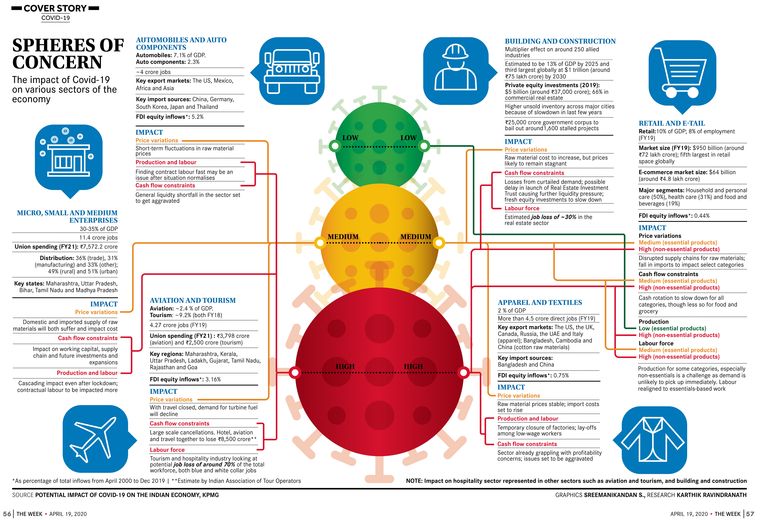For managers of Covid-19 in India, the next few days will be crucial. The backdrop of rising cases—5,274 as on April 8—has only added to the policymakers’ dilemma of extending the lockdown and handling the situation on the ground, given India’s unique medical, economic, social and psychological challenges.
Experts are closely following the movement of the epidemiological curve of Covid-19, but they say that it is still “too early” to comment on whether the curve had “peaked” or flattened yet. “The cases we are seeing now are of people who acquired the infection prior to the lockdown,” says Dr Tarun Bhatnagar, epidemiologist, Indian Council of Medical Research-National Institute of Epidemiology. Data from the coming week would also be crucial in deciding on the lifting of restrictions. “The spike from one big cluster may not indicate a national trend,” says Bhatnagar, who is also a member of the national task force for Covid-19. “Besides, we would also need to analyse whether these primary cases have resulted in secondary and tertiary transmission, and if so, what is the extent of those cases.”
Dr Giridhar R. Babu, professor and head, lifecourse epidemiology, Public Health Foundation of India, says that the “real curve” will be understood only when India follows a “syndrome-based” surveillance for Covid-19 throughout the country and expands testing. This approach implies that all cases of fever, cough, malaise and any other respiratory symptoms must be treated as Covid-19, unless proved otherwise, and home isolation of patients must be ensured.
“Until that happens, we will not know the real case burden and doubling rate,” says Babu, intermediate fellow, DBT/Wellcome Trust India Alliance. “The current trajectory is not the real curve. The doubling rate of infection also depends on consistent efficiency of testing and reporting systems. Hence, we cannot comment on flattening the curve yet.”
Going forward, Bhatnagar says that those involved in managing the epidemic will be focusing not only on the states and districts, but also they will be zooming in on the individual clusters and hotspots to analyse what is working and what is not. “The decision to lift a lockdown would rest on several factors, including whether enough testing is being done, if the surveillance is robust, as well as the economic and social factors, too,” he says.
At a micro level, the health ministry has drawn up an elaborate plan for containing the epidemic. Drawing lessons from the H1N1 pandemic of 2009, where the spread of the disease was not uniform, the ministry has put forth an action plan for “large outbreaks” that involves active surveillance, expanding lab capacities for testing of all suspected cases, high-risk contacts and severe acute respiratory infection (SARI) cases. With plans to start the cheaper and faster antibody-based tests in hotspots in the coming days, the government is also hoping to understand the spread of SARS-CoV-2, the virus behind Covid-19.
On the ground, however, India’s health care systems are being put to the test. There are issues involving testing, the quality of health infrastructure that is being ramped up almost overnight and costs attached with diagnostics and treatment. While Central planning is important and will continue, the management of the disease at the state and district levels and at individual hotspots will determine how India overcomes the crisis.
And that will not be easy. A doctor from a medical college in a district in West Bengal outlines a few challenges that confront those on the ground, away from the metros. “There is a need to streamline the process for testing all SARI patients,” says the doctor who did not wish to be named. “We now know that 6 per cent of all Covid-19 patients will develop SARI. However, testing these patients requires permission from the chief medical and health officer, which, at least in our district, has not been forthcoming.”
State governments are creating designated hospitals for Covid-19 patients, but in certain districts, their quality was suboptimal. “At this point, it would be prudent that all hospitals are readied for Covid-19 management, and not just the designated ones,” says the Bengal-based doctor. “Given that 20 per cent of all people infected with SARS-CoV-2 show no symptoms but are still capable of spreading the infection, we need to be careful while seeing all patients. All hospitals should be ready for that. Besides, it reduces the burden on patients to travel to the designated hospital, which might be far from where they reside.”
While the government was focusing on arranging ventilators, it also had to work on a strategy to manage patients better early on. “When a patient is put on a ventilator, there is a 50 per cent chance that he will survive,” says the doctor. “A better strategy instead would be to focus on managing these patients early on with oxygen
therapy and other noninvasive treatment strategies so that they don’t end up on ventilator, and death rates can be brought down further.”
In the coming week, even as the health infrastructure is ramped up further and states demand an extended lockdown, experts say the lockdown cannot be an end in itself. “Right now, with the lockdown,
we have already slowed the spread of the virus, but these gains must be maintained by the actions we take after the lockdown,” says Gagandeep Kang, director, Translational Health Science and Technology Institute, an autonomous institute under the department of biotechnology. “We have already changed behaviour; I see masks everywhere. If we can maintain hand-washing, staying away from others when we are ill and being extra careful around the elderly and vulnerable, then we will definitely slow the spread of the virus. By how much, we do not know yet. So, we need to work as a society to do that.”




